
Welcome back geek friends on the guide to your assembled PC! For those who have lost them, below you will find the list of previous articles for the deepening and choice of processor, motherboard, memories, video card and power supply.
ALL EPISODES:
Chapter 1: Guide to building your assembled PC: THE BASICS
Chapter 2: Guide to building your assembled PC: PROCESSOR AND HEAT SINK
Chapter 3: Guide to building your assembled PC: THE MOTHERBOARD
Chapter 4: Guide to building your assembled PC: RAM, HDD and SSD M.2
Chapter 5: Guide to building your assembled PC: THE VIDEO CARD
Chapter 6: Guide to building your assembled PC: THE POWER SUPPLY
Chapter 7: Guide to building your assembled PC: THE CASE
Today we will see together the seventh and last chapter of this little saga, the one in which we will analyze and evaluate where to house all the components chosen previously. In short, we speak of case.
The importance of choosing the best case for your PC
Exactly, for some the cabinet is just the metal box where to insert the PC components, for others it is a very important component to order and keep all the hardware fresh and for many others it is a real temple, the sacred armor where dwells the body and spirit of this mystical object which is our computer.
From the Gold of Thanos' glove to that of Virgo's Shaka, let's not bother the Gold Saint again; but let's go immediately to see which parts the case is made up of and what are the elements to take into consideration in its choice.
Dimensions. Each desk has its own case.
When is the right time to choose the case when buying components?
My girlfriend would reply: "When we move house!".
Size is everything in this case. In fact, not everyone can afford to transform the guest room into the super giant study / playstation that we all dream of, so, first of all, we will have to ask ourselves where we are going to place our PC.
As we have already seen in the dedicated article, in fact, the relationship between the motherboard and the case will be crucial to understand the real dimensions of your station. It goes without saying that in a larger cabinet we will be able to insert a smaller motherboard, but vice versa an ATX mobo, for example, will not fit in a very low volume case.
If the space available allows it, then we will have type houses full tower, generously sized for standard E-ATX and ATX motherboards, case middle tower for medium sized ATX and Micro ATX cards, and finally configurations micro tower for Mini ITX cards with very limited dimensions.
But remember that the choice of the motherboard and therefore the case are not a question of power, but rather of expandability e ventilation.
Expandability. A multiverse of future possibilities.
Another way to indirectly ascertain how much space you can allow yourself is to first understand how much hardware you need to build the build you have in mind.
In fact, video cards, sound cards, discs and heatsinks can have very different dimensions and dimensions and check first in the case specifications if they are supported is always an excellent practice to avoid having to return most of our components.
Let's say you want to install multiple PCIe devices. Surely the card will not be a Mini ITX that has only one such port, but if you want to install an all-in-one liquid cooler you will still have to check first that the dimensions of the radiator are compatible with the chosen case.
In fact, to cool the processor, this type of heat sinks make use of systems that circulate a continuously moving water flow inside them and cooled, in fact, by fans that push fresh air over the radiator where the water previously heated by the processor working.
So the size of the radiator is given not only by its thickness, but also by the size and number of fans that perform this task.
Usually the fans can be from 120 or 140mm for 120mm single fan radiators up to the most bulky 360, or even 480mm for systems with 3 or 4 fans in a row. The greater their sum, the higher the ability to keep your CPU cool.
Other components to be aware of are discs. As we have seen they can have different cuts and, apart from the M.2 or PCIe ones that connect directly to the motherboard, the vast majority of people still rely on 2,5 or 3,5 "models.
Currently the houses prepare many different areas for 2,5 ”SSDs and being able to insert even 3 or 4 is almost never a problem; on the other hand, the story is different for the 3,5 ”ones that hardly have more 3 bays available for housing.
In any case, on the manufacturers' websites the dimensions and compatibilities are usually described very clearly and being able to consult them will be very easy for you.
Components and Airflow. The art of dominating the air.
In the choice of the case, as mentioned, the eye also wants its part. It is no coincidence that all the houses currently on the market increasingly resemble small cabinets where the internal components can be displayed in the light of RGB lights.
But do you know why aluminum and glass are the main materials used?
Exactly, just for the temperature!
The main feature of the case, in addition to containing the action figures of our favorite video game, is above all that of keeping the inside of our PC as cool as possible by means of a flow of air that passes through it.
So here we are talking about Airflow and air pressure positive, negative o neutral depending on whether the positioning of the fans inside the case and the ratio between fresh air introduced and hot air expelled is more or less balanced.
Generally configurations are preferable where the ratio of the incoming air is higher or equal to the outgoing one, where precisely positive or neutral flows guarantee greater dissipation to our internal components.
But how exactly is PC cooling calculated?
An exact formula does not exist, but it is usually necessary to calculate the size and number of fans that push air into the computer, usually placed on the front, and those that throw it out placed on the back or on the top of the case. A very common configuration in fact consists of two front fans and one or two rear or top fans, which generate positive or neutral pressure as seen.
Extras and custom cases. Power to the imagination.
Last but not least element to consider is made up of those "extra" possibilities that a case can give, that is, those that are not always present, but always decisive in the assembly or maintenance phase.
I speak for example of modular homes where it is possible to detach some components during the construction of the PC, or structures that include holes, bulkheads, housings and Velcro strips for the cable management (the art of hiding the cables), which as we have seen when talking about power supplies, have a decisive influence on the air flow of the case.
And also dust filters, pre-installed controllers for managing the fans or USB or video expansion ports on the front panel.
Some models even have compartments to hide the power supplies in order to better accommodate even the most powerful and bulky ones, in case you are considering a 4 video card configuration and you need 1.21 Gigawatts of power!
In short, the differences that distinguish a good case from a less good one often lie in the small details and indeed the same concept of parallelepiped houses can be distorted if the conditions listed above for cooling and space are respected.
Have you ever seen a pyramid-shaped case? Or built into a desk, or even hung on the wall ?!
Here is a great roundup of some of the most beautiful builds in the world found on Instagram:
Ok, let's go now to see the models recommended by your Japan Tomato as always!
500 € configuration - Let's get off to a great start!
In this first band we have the Noua Utopia F3 and Sharkoon TG4 RGB., two cabinets that with around € 60 already give us everything we could want from a gaming or work computer. Large tempered glass bulkheads (a real rarity in this price range), a set of pre-installed fans for good air flow and a chassis with a good predisposition to cable management.
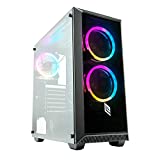 Noua Utopia F3 Black Case ATX per PC Gaming 0.65MM SPCC...
Noua Utopia F3 Black Case ATX per PC Gaming 0.65MM SPCC...
- Noua Utopia F3 is a 0.65 mm SPCC frame case, compatible with ATX, m-ATX, mini-ITX motherboard;
- Front in Plexiglass and side panel in TEMPERED GLASS where it will be possible to highlight all the ...
- 3xFan RGB Rainbow Dual Halo pre-installed (6pin): 2 front, 1 rear; possibility to install on the panel ...
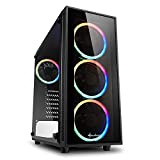 Sharkoon TG4 RGB PC-Case
Sharkoon TG4 RGB PC-Case
- MODERN GAMER LOOK: The TG4 with tempered glass front and side panels and brightly colored fans, ...
- COMPACT DESIGN CASE: The case is designed to be essential, efficient and as compact as possible.
- CHOICE OF VERSIONS: The TG4 is available in three versions, with four addressable RGB LED fans, in the version ...
Configuration from 1000 € - Design first and foremost
In the second budget we can afford two of the most famous brands of houses that exist: Fractal design with the model Meshify C e NZXT with its H500 B. If you are looking for a model with minimal lines and excellent materials, you have found them. The two houses are in fact characterized by a high attention to detail and also offer many different combinations of colors, which is also quite rare.
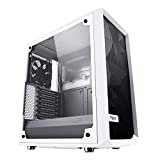 Fractal Design Meshify C - Compact Mid Tower Computer Case -...
Fractal Design Meshify C - Compact Mid Tower Computer Case -...
- Aerodynamic, high-airflow design: the performance and capacity of a mega tower in a mid-tower ...
- Unique new style with black-on-black camouflaged aesthetic: mesh front corner panel designed for ...
- Flexible storage options: space for up to 5 drives with sturdy steel mounts with anti-vibration pads ...
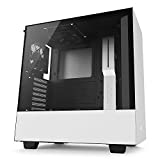 NZXT H500 - Case ATX/microATX/mini-ITX Mid-Tower per PC -...
NZXT H500 - Case ATX/microATX/mini-ITX Mid-Tower per PC -...
- PREMIUM QUALITY: All-steel construction with the elegant H Series design; available in four ...
- FULLY TEMPERED GLASS PANEL: Put your unit in the spotlight with crisp clarity
- NEW CABLE MANAGEMENT SYSTEM: Features a dual position cable management bar and cable management kit ...
Configuration from 2000 € - The A series
Here are two high-end houses for quality and modularity: the Cooler Master MasterCase H500P and the little known Sahara P35.
Also in this case we have a mid tower form factor but capable of hosting E-ATX and standard ATX motherboards respectively, two excellent solutions if the space at your disposal is not lacking.
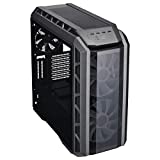 Cooler Master MasterCase H500P – Case per PC RGB con Due...
Cooler Master MasterCase H500P – Case per PC RGB con Due...
- TWO 200MM RGB FANS - Two 200mm MF200R RGB fans draw high volume airflow into the case for a ...
- PC BUILDERS IN MIND- A DIY case, the clear front panel and the top drain panels and ...
- TEMPERED GLASS SIDE PANEL - The easy-to-remove light gray tinted side panel combined with ...
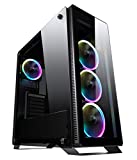 Sahara Case per PC (P35 SYNC 4 ventole Pirate True RGB),...
Sahara Case per PC (P35 SYNC 4 ventole Pirate True RGB),...
- SYNC RGB.
- RGB standalone.
- RF remote control included.
Configuration from xxx € - Over the top!
As always at the top end we simply consider the best:
Corsair Obsidian 500D RGB e Phantek Evolv X.
The dimensions are obviously important for both models but as you have already understood they are designed to have a large margin of expandability and the possibility of being opened and modified frequently.
The first offers glass panels on all three main sides, 4 pre-installed addressable RGB fans and a Corsair proprietary controller for managing the lighting effects of the fans via ICUE software.
The Phantek, on the other hand, always has a double glass panel on both sides and a satin metal design in 3 different shades that winks a lot at the Apple world. We also always find pre-installed RGB strips and a wide range of accessories such as the GPU riser to position our video card vertically.
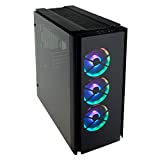 Corsair Obsidian 500D RGB SE Case da Gaming Mid-Tower...
Corsair Obsidian 500D RGB SE Case da Gaming Mid-Tower...
- Sharp and black: iconic style of the Obsidian series, which combines a front panel in smoked tempered glass and lines ...
- Improved Construction: Solid aluminum top plate and door handles add a touch of ...
- RGB Lighting: Three LL120 RGB fans create a symphony of colors
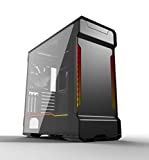 PHANTEKS PH-ES518XTG_DBK01 Enthoo Evolv X Midi-Tower Vetro ...
PHANTEKS PH-ES518XTG_DBK01 Enthoo Evolv X Midi-Tower Vetro ...
- Product for demanding players
- Irreproachable production quality
- Exceptional dive
Perfect, that's all for this article too, we just have to snap our fingers with the power glove, wait for the sweet sound of the fans and the color of the RGB to light up the dim light of our room and then see the magic of the PC of our dreams. finally start for the first time!
Thank you for following our guide and I hope to find you again soon here on the pages of!
SEE YOU SPACE COWBOY…


























